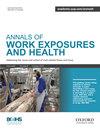112 An alternative to the HSE/NPL phase contrast test slide for airborne asbestos fibre analysis laboratories
IF 1.8
4区 医学
Q3 PUBLIC, ENVIRONMENTAL & OCCUPATIONAL HEALTH
引用次数: 0
Abstract
More than 55 years ago, an analytical technique employing phase contrast microscopy was developed for the quantitative estimation of airborne asbestos fibre concentration. It was found that the detection limit of these microscopes was dependent upon microscope design, set-up and observer performance. In the late 1970’s the HSE/NPL Phase-Contrast Test Slide was developed that facilitated the standardisation of detection limits of microscopes and observers in laboratories around the world. An alternative test slide has now been developed using state of the art nano-metre fabrication technology, and is known as the Pickford Phase Contrast Test Slide, and manufactured by PhaseSlides. Both subjective and newly developed objective visibility testing show that the Pickford Test Slide is equivalent to the HSE/NPL Test Slide, and users report it to be much easier to use. Each Pickford Test Slide is certified by the Environmental Analytical Laboratory of the Southern Cross University – stating that it is equivalent in performance to that of the HSE/NPL test slide. Acknowledgement to the BOHS Annals of Work Exposures and Health.112 用于空气传播石棉纤维分析实验室的 HSE/NPL 相衬测试玻片替代品
55 年前,人们开发了一种采用相衬显微镜的分析技术,用于定量估算空气中石棉纤维的浓度。研究发现,这些显微镜的检测限取决于显微镜的设计、设置和观察者的表现。20 世纪 70 年代末,HSE/NPL 相衬测试载玻片问世,促进了世界各地实验室显微镜和观察者检测极限的标准化。现在,利用最先进的纳米制造技术开发出了另一种测试玻片,称为皮克福德相位对比测试玻片,由 PhaseSlides 公司制造。主观能见度测试和新开发的客观能见度测试表明,皮克福德测试玻片与 HSE/NPL 测试玻片相当,而且用户反映它更容易使用。每块 Pickford 测试玻片都经过南十字星大学环境分析实验室的认证,证明其性能等同于 HSE/NPL 测试玻片。鸣谢《BOHS 工作暴露与健康年鉴》。
本文章由计算机程序翻译,如有差异,请以英文原文为准。
求助全文
约1分钟内获得全文
求助全文
来源期刊

Annals Of Work Exposures and Health
Medicine-Public Health, Environmental and Occupational Health
CiteScore
4.60
自引率
19.20%
发文量
79
期刊介绍:
About the Journal
Annals of Work Exposures and Health is dedicated to presenting advances in exposure science supporting the recognition, quantification, and control of exposures at work, and epidemiological studies on their effects on human health and well-being. A key question we apply to submission is, "Is this paper going to help readers better understand, quantify, and control conditions at work that adversely or positively affect health and well-being?"
We are interested in high quality scientific research addressing:
the quantification of work exposures, including chemical, biological, physical, biomechanical, and psychosocial, and the elements of work organization giving rise to such exposures;
the relationship between these exposures and the acute and chronic health consequences for those exposed and their families and communities;
populations at special risk of work-related exposures including women, under-represented minorities, immigrants, and other vulnerable groups such as temporary, contingent and informal sector workers;
the effectiveness of interventions addressing exposure and risk including production technologies, work process engineering, and personal protective systems;
policies and management approaches to reduce risk and improve health and well-being among workers, their families or communities;
methodologies and mechanisms that underlie the quantification and/or control of exposure and risk.
There is heavy pressure on space in the journal, and the above interests mean that we do not usually publish papers that simply report local conditions without generalizable results. We are also unlikely to publish reports on human health and well-being without information on the work exposure characteristics giving rise to the effects. We particularly welcome contributions from scientists based in, or addressing conditions in, developing economies that fall within the above scope.
 求助内容:
求助内容: 应助结果提醒方式:
应助结果提醒方式:


